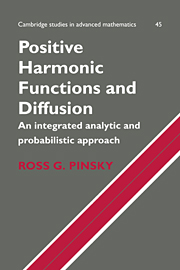Book contents
- Frontmatter
- Contents
- Preface
- List of notation
- 1 Existence and uniqueness for diffusion processes
- 2 The basic properties of diffusion processes
- 3 The spectral theory of elliptic operators on smooth bounded domains
- 4 Generalized spectral theory for elliptic operators on arbitrary domains
- 5 Applications to the one-dimensional case and the radially symmetric multi-dimensional case
- 6 Criteria for transience or recurrence and explosion or non-explosion of diffusion processes
- 7 Positive harmonic functions and the Martin boundary: general theory
- 8 Positive harmonic functions and the Martin boundary: applications to certain classes of operator
- 9 Bounded harmonic functions and applications to Brownian motion and the Laplacian on a manifold of non–positive curvature
- References
- Index
6 - Criteria for transience or recurrence and explosion or non-explosion of diffusion processes
Published online by Cambridge University Press: 02 December 2009
- Frontmatter
- Contents
- Preface
- List of notation
- 1 Existence and uniqueness for diffusion processes
- 2 The basic properties of diffusion processes
- 3 The spectral theory of elliptic operators on smooth bounded domains
- 4 Generalized spectral theory for elliptic operators on arbitrary domains
- 5 Applications to the one-dimensional case and the radially symmetric multi-dimensional case
- 6 Criteria for transience or recurrence and explosion or non-explosion of diffusion processes
- 7 Positive harmonic functions and the Martin boundary: general theory
- 8 Positive harmonic functions and the Martin boundary: applications to certain classes of operator
- 9 Bounded harmonic functions and applications to Brownian motion and the Laplacian on a manifold of non–positive curvature
- References
- Index
Summary
Introduction
In this chapter, we will assume that V ≡ 0. In Chapter 4, it was shown that in this case, criticality and subcriticality are equivalent to recurrence and transience, respectively, and that, in the critical (recurrent) case, the product L1 property is equivalent to positive recurrence. It was also shown that the function Φ ≡ 1 is not invariant for the transition measure p(t, x, dy) if and only if the diffusion explodes. In Chapter 5, integral tests were given which allow one to distinguish between transience and recurrence, between null recurrence and positive recurrence, and between explosion and non-explosion in the one-dimensional case. The multidimensional case is much more involved and does not yield a simple solution. In Section 1–3, we develop the Liapunov technique for considerations of transience and recurrence. For diffusions with appropriate coefficients, this technique is used to give sufficiency conditions for transience, for recurrence, for null recurrence and for positive recurrence in terms of integral tests. In Section 4, we present a variational approach to transience and recurrence for diffusions corresponding to symmetric operators. By exploiting the classical Dirichlet principle, a necessary and sufficient condition for transience or recurrence is given in terms of a variational formula. From this, one can extract sufficiency conditions for transience and for recurrence in terms of integral tests. The variational method also reveals an important comparison principle concerning transience and recurrence for such diffusions. In Section 5, we develop a generalized Dirichlet principle for general operators which is then used in Section 6 to give a necessary and sufficient condition for transience or recurrence in terms of a mini-max variational formula.
Information
- Type
- Chapter
- Information
- Positive Harmonic Functions and Diffusion , pp. 235 - 282Publisher: Cambridge University PressPrint publication year: 1995
